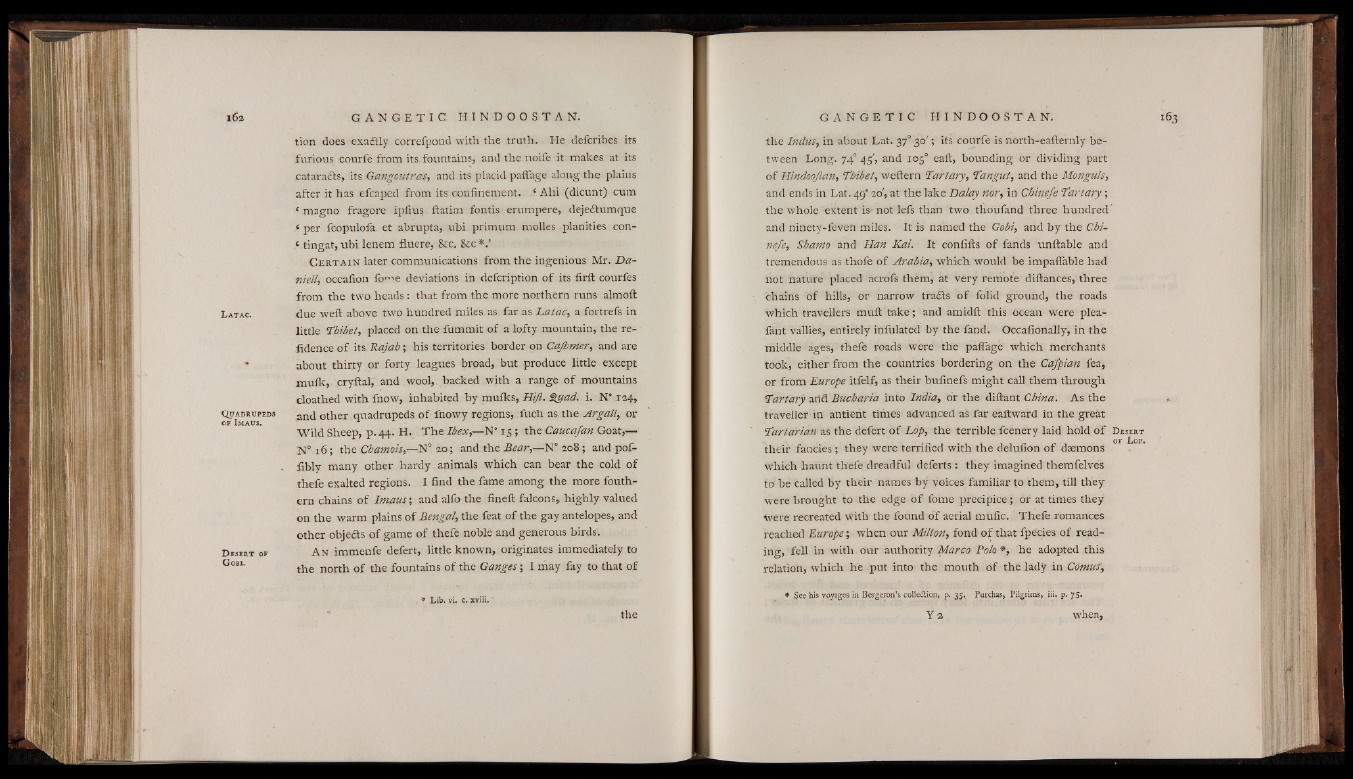
L a t a c .
Q uadrupeds
of 1m a us.
D esert of
G obs.
tion does exactly correfpond with the truth. He defcribes its
furious courfe from its fountains, and the noife it makes at its
cataracts, its Gangoutras, and its placid paffage along the plains
after it has efcaped from its confinement. ‘ Alii (dicunt) cum
‘ magno fragore ipfius ftatim fontis erumpere, dejedtumque
‘ per fcopuloia et abrupta, ubi primum molles planities con-
‘ tingat,ubi lenem fluere, fee. fee*.’
C e r t a i n later communications from the ingenious Mr. Daniel!,
occafion fome deviations in defcription of its firft courfes
from the two heads: that from the more northern runs almoft
due weft above two hundred miles as far as Latac, a fortrefs in
little Thibet, placed on the fummit of a lofty mountain, the re-
fidence of its Rajah; his territories border on Cafinier, and are
about thirty or forty leagues broad, but produce little except
muik, cryftal, and wool, backed with a range of mountains
cloathed with fnow, inhabited by muiks, Hiß. guad. i. N' 124,
and other quadrupeds of fnowy regions, fuch as the Argali, or
Wild Sheep, p. 44. H. The Ibex,— N° 15; the Caucafan Goat,—
N° 16; the Chamois,— N° 20; and the Bear,— N° 208; and pof-
fibly many other hardy animals which can bear the cold of
thefe exalted regions. I find the fame among the more fouth-
ern chains of Imaus; and alfo the fineft falcons, highly valued
on the warm plains of Bengal, the feat o f the gay antelopes, and
other obje&s of game of thefe noble and generous birds.
A n immenfe defert, little known, originates immediately to
the north o f the fountains o f the Ganges; I may fay to that o f
the Indus, in about Lat. 370 30'; its courfe is north-eafternly between
Long. 74° 45', and 105° eaft, bounding or dividing part
o f Hindoojlan, Thibet, weftern Tartary, Tangut, and the Monguls,
and ends in Lat. 49’ 20', at the lake Dalay nor, in Chinefe Tartary;
the whole extent is-not lefs than two thoüfand three hundred
and ninety-feven miles. It is named the Gobi, and by the Chinefe,
Shamo and Han Kai. It confifts o f fands unftable and
tremendous as thofe of Arabia, which would be impaflable had
not nature placed acrofs them, at very remote diftances, three
chains of hills, or narrow traéis o f folid ground, the roads
which travellers muft take; and amidft this ocean were plea-
fant vallies, entirely infulated by the fand. Occafionally, in the
middle ages, thefe roads were the paffage which merchants
took, either from the countries bordering on the Cafpian fea,
or from Europe itfelf, as their bufinefs might call them through
Tartary arid Bucbaria into India, or the diftant China. As the
traveller in antient times advanced as far eaftward in the great
Tartarian as the defert o f Lop, the terrible fcenery laid hold o f D esert
. _ of L op.
their fancies; they were terrified with the delufion of daemons
which haunt thefe dreadful deferts : they imagined themfelves
to be called by their names by voices familiar to them, till they
were brought to the edge o f fome precipice; or at times they
were recreated with the found o f aerial mufic. Thefe romances
reached Europe; when our Milton, fond of that fpecies of reading,
fell in with our authority Marco Polo *, he adopted this
relation, which he put into the mouth of the lady in Comus',
* See his voyages in Bergeron’s collection, p. 35. Purcfras, Pilgrims, iii. p. 75.
Y 2 . when,